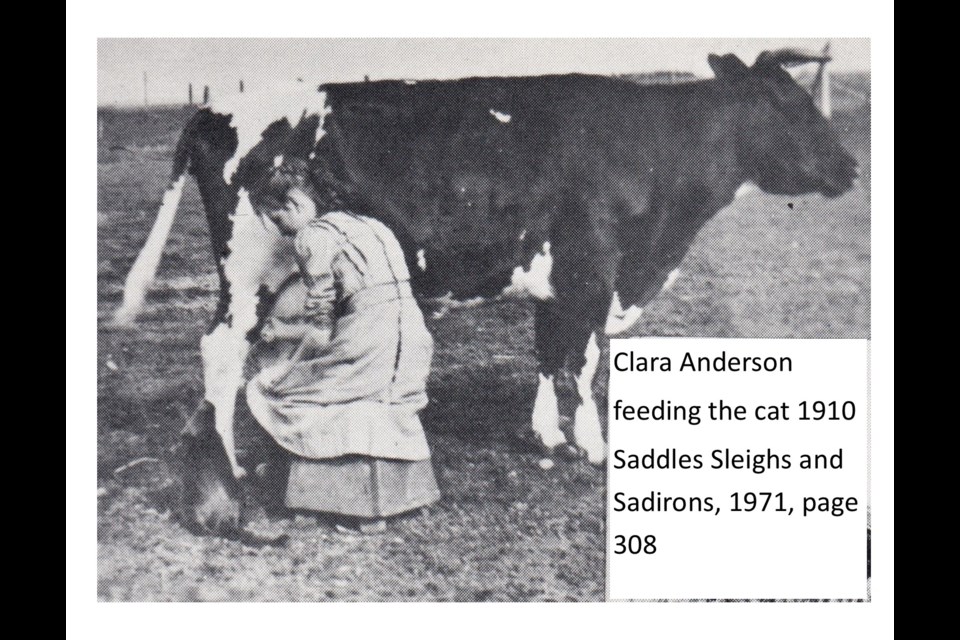The Chestermere Historical Foundation will hold a special presentation on Chestermere’s dairy farm history on Feb. 20.
Entitled “Dairying in Chestermere,” the presentation will be held at the Chestermere Recreation Centre starting at 2 p.m. Coffee, snacks and homemade ice cream will be available for those who come out.
The presentation will be hosted by Chestermere Historical Foundation board member Kay Clarke, who will draw on her own family background and experience to talk about how dairying underwent significant changes between the 1940s and 1960s. She will also look back further in time to the days of Chestermere’s early 20th century pioneers, many of whom relied on milking cows to supplement their modest living.
“One of the things that happens early on when these areas were being settled, farmers needed an income, and dairy, even a small amount of dairy, provided an income,”explained Clarke in a recent interview with the Rocky View Weekly. “There were many farmers around Chestermere who didn’t do dairying in a big way. They maybe had two or three cows. Maybe they sold a little milk to Swift’s Creamery (in Calgary) or maybe some other place like that … But it was business, and it earned people money in times when they maybe had not much else.
“It was something you could rely on outside of the weather,” she stated.
In the early days, Clarke recounts how whole milk and cream used to be taken right from the cows, put in milk cans, and delivered by farmers directly to local customers.
“They carried the milk in one quart cans, and filled it from the wagon with whatever the customer brought out for them to fill,” explained Clarke.“That changed, of course, in just about the First World War, and at the United Farmers of Alberta. Women were very important in getting some health legislation enacted so that dairy had to be processed before it was sent out.”
During her family’s time in the dairy business starting in about 1938, Clarke said it was still typical for her father to milk his cows by hand and transport the milk in eight quart metal cans to the Union Dairy in Calgary.
Clarke still has fond memories of the feral farm cats gathering at the milking stalls twice a day, at 4 a.m. and 4:30 p.m.
“Before they could milk, farmers had to do a few squirts to get going,” she recalled. “There were always barn cats around and they would wait, and they would be there when it was milking time, and they would be there meowing for the squirt of milk.”
Clarke said because of the daily nature of the milking work her family rarely went on holidays, or would have to rely on their neighbours to do the daily milking for them if they wanted to get away for a few days. Of course, her dad always made sure to return the favour.
Clarke said the dairy farms in the area made for a close-knit community, and then later embraced organizations like the Alberta Dairymen’s Association, which provided additional support and information to help them navigate a changing industry.
As the milk business in Alberta became more centralized and organized, new technologies and new standards were brought in to ensure health, safety and quality– including getting rid of the milk cans. This pretty much ended the small farm dairy business in the province as many couldn’t afford to upgrade to bulk tanks.
“(The Union Dairy) decided about 1955 or so that they would stop selling milk in cans,” Clarke explained. “They (now) would only receive milk in bulk tanks. My father was one of the only few who decided to upgrade.”
Of course, says Clarke, not all innovation was bad. Her family was able to upgrade to automatic milking machines by the 1960s, and this cut down on their manual work considerably.
However, as time moved on, and more suburban development began to happen in Chestermere, and dairy farming operations seemed to get bigger and bigger, Clarke said her family decided to retire from the milk business. She admits to having nostalgia for the old days when Chestermere was a more rural and closely connected community, and the particularly strong friendships she and her family held within the local dairy community.
“Things have changed over the years,” she said wistfully. “You know the encroaching residential nature of Chestermere has meant that nobody's even farming around here anymore.”



